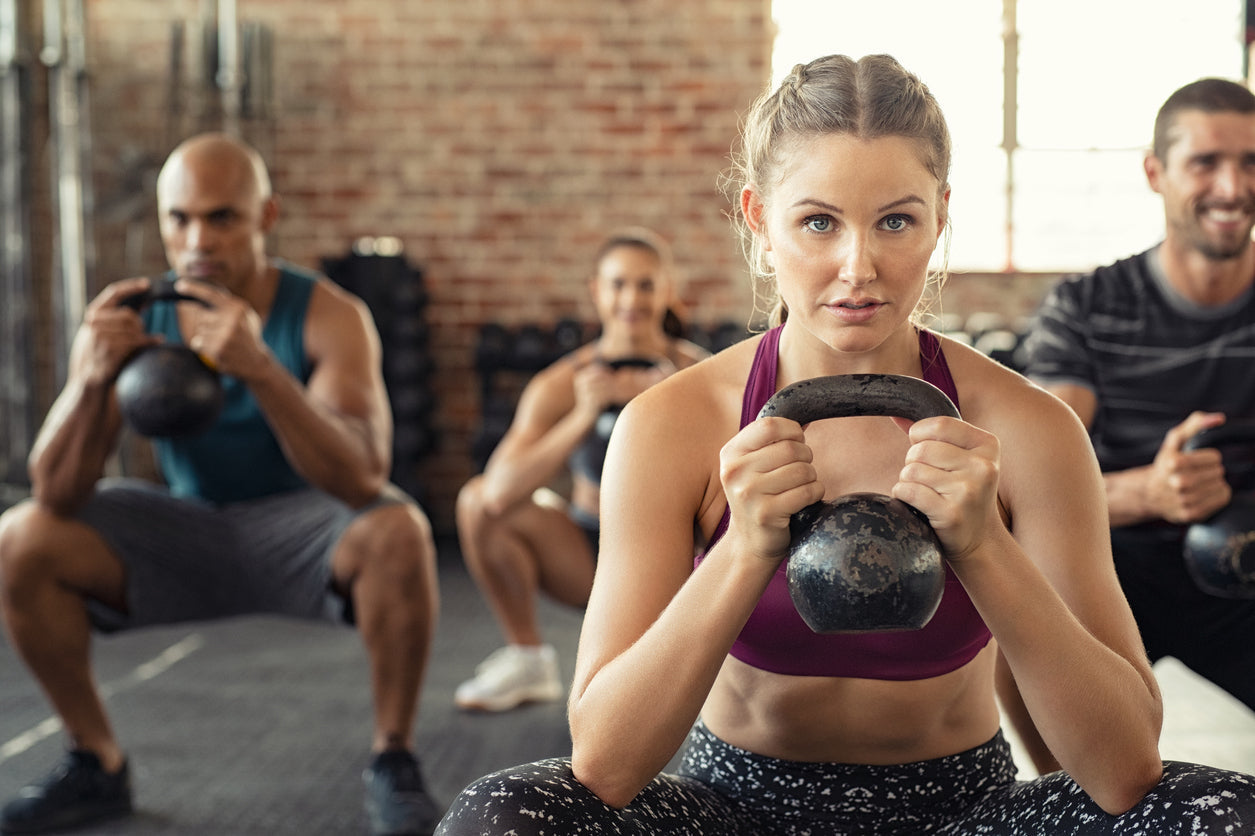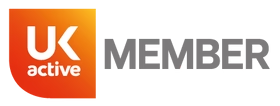We asked Personal Trainer and Study Active assessor Rebecca Ireland to share her advice and recommendations for getting the most out of using kettlebells and creating effective kettlebell workouts.
IMPORTANT: The ideas in this article are purely for information only – please do not start an exercise programme until you have completed a PAR-Q and, if necessary, received medical clearance. Always warm up and cool down and never do any exercise that you are unsure of without the support of a qualified professional.
To start us off, what are the benefits of full body kettlebell exercises?
Kettlebells (KB/s) are beneficial for many different reasons. Just to name a few, they are great for improving endurance using low impact training, increasing overall body strength, and improving coordination and mobility.
For personal trainers looking to enhance their kettlebell workout knowledge and certifications, PT Cert offers a range of courses designed to help you master these exercises.
Let’s dig down and look at each of those in more detail...
Endurance
Unlike most cardiovascular exercises KBs can be used as a form of low impact CV training. When training with kettlebells, the body utilises explosive power through maximising and minimizing speed. This is known as ballistics training. Kettlebell circuits are short and intense, therefore using the cardiovascular system which will boost your endurance, helping you to be more efficient in other types of CV training.
Full body strength
Using kettlebells can aid in improving strength and even build muscle mass. The majority of KB exercises recruit every muscle in the body from head to toe. As mentioned previously, kettlebells are used through maximising speeds in an explosive nature like a clean and press, or slowed right down minimising speed which are slow and controlled like windmills. Both exercises activate muscles all over the body and when performing either type of movement, core contraction and coordination involved in these movements intensifies your breathing and causes the abdominal muscles to stimulate. This results in improving your core, which is extremely beneficial as it not only increases core strength but also stability.
Coordination and mobility
When using a kettlebell, you must have some sort of co-ordination and mobility. For example, when performing a KB snatch, you must have sufficient shoulder mobility and overhead stability to ensure the weight is in the correct overhead position. You also need to have the ability to understand and feel the sensations of your movements and awareness of your body when performing a move. Anything that requires body movement, when you compress or tense your muscles they detect and communicate sensory information about movement and posture. This is known as kinaesthetic. You need kinaesthetic awareness to ensure that when you perform a KB snatch that you move your hand into the correct position above the head without hitting yourself on the back of the forearm with the KB. Ouch!
Fortunately, with kettlebell training you don’t have to have this mobility and coordination from the get-go! It can be developed over time and with the right exercises e.g., windmills, and Turkish get- ups which are slow and controlled, can help improve shoulder mobility, overhead stability and co-ordination. Deep KB goblet squats, and KB deadlifts are great for developing hip mobility which will help you progress onto more complex KB moves where co-ordination and mobility is a must.
Sounds like kettlebells are a fantastic piece of equipment to add into your gym workout. Can you take us through some examples of kettlebell exercises to target different areas?
Kettlebell Chest Workout/Exercises
- KB Bench Press - Similar to a dumbbell (DB) bench press but using KBs, make sure you keep your wrist straight and rest the KB near the ball of your thumb.
- KB Chest Flies - Again, similar to DB chest flies but using KBs, makes sure you start lighter than you would a DB, slight bend in the elbows, do not fully extend.
- Standing KB Chest Press - Hold the KB with both hands placing your thumb and index figure around the handle and palms around the weighted part at the bottom, so you are holding the full KB and not the handle. Start with the KB near the middle of your chest with elbows out, extend the arms out in front of you keeping the KB central. Then return to starting position.
- Close Grip KB Press - Which can be progressed onto a KB Push Up with a Renegade Row.
- KB Push Up with a Renegade Row -Similar to close grip press on dumbbells, keep a wider stance than a regular press up. Grab the KBs by the handle, keep the wrist straight, lower the body until chest is in line with the wrist, extend the elbows and push the palms into the handles of the KBs to return to starting position.
- To progress to a KB renegade row, again like a DB renegade row, keeping the body in a neutral position lift the KB into a row, keeping the elbow in, return to starting position and swap sides.
- Turkish Get Up -From a side-lying position, lift the KB and lie onto your back. Bring your right leg in while the left is extended. Press the KB above your head and into the air with the right hand, while the left hand is firmly on the ground. Come up on your left elbow. Then sit up making sure the KB is still above your head and in the air. Drive your hips into the air. Sweep your leg into a kneeling position. Rotate the back knee so that your body is in a lunge position. Step forward and stand up straight. Keep the KB above your head, and your arm locked out. Reverse the movement to return to the starting position.
Upper Body Kettlebell Workout/Exercises
- Alternating KB Single Arm Bench Press - As stated above, this is similar to a KB Bench Press, but using one arm at a time, alternating the right arm and then the left, keeping the opposite arm in contraction.
- KB Pullovers – Similar to a dumbbell pullover but using a kettlebell. Always make sure that your back is flat on the bench. Lighter weight than a DB, keep the body tight, pick up the KB by the handles with the bottom of the KB facing your head. Extend the arms, let the KB fall back above the head until it is almost touching the floor, and slowly and controlled bring the KB back to the starting position.
-
KB Front Raises - Can be performed either single with arm or double arm using one kettlebell. Again, similar to a DB front raise but with a KB.
- Single arm, hold the KB by the handle keeping the body still, and hands facing the floor at all times raise the KB to shoulder height, and then return to starting position.
- Double arm, hold one KB in an overhand grip with both hands. Lift the KB up in front of the chest using the shoulders. Once at shoulder height return to starting position.
- KB High Pulls -The KB swing must be mastered before doing this exercise. Perform a regular single arm KB swing just to shoulder height, as you reach the top of the swing squeeze the shoulder blades, pulling the elbow and KB back and keeping the wrist straight. Do not allow the KB to move position, push the KB forward and extend the arm so it is in front of you, then finish the eccentric part of the swing. Use the opposite arm for balance.
- KB Halos - Hold the KB by the bottom, so palms around the weight rather than the handles, extend arms above the head, and rotate the KB around your head, keeping the head still and core tight).
Kettlebell Lower Body Workout/Exercises
- Kettlebell Swings -Stand with feet wider than the shoulders, hold the KB with both hands in an overhand grip, safely lift from the floor. Contract the glutes and hamstrings and allow the KB to swing naturally to shoulder height. Do not use the shoulders to lift. Allow the KB to swing back between your legs again, hinging the hips back, keep back flat and torso tight, and repeat.
- KB Back Squat -Similar, to a regular barbell back squat, but with KBs and a lighter weight. With KBs your core will work harder to stabilise the weight of the KB’s. Rest a KB on the back of each shoulder, forearms and palms facing up, lower into a squat so thighs are parallel to the floor, keep chest up and torso tight, maintaining a neutral position drive through the heels and up to standing.
- KB Walking Lunges -Again similar, to a regular DB walking lunge but with KBs. Using KBs will increase the intensity as the bells swing, challenging your balance more. You can hold the KBs by the handles in each hand, or you can hold the KB in a goblet position or racked position. You can also perform an overhead KB lunge, which will challenge your shoulder stability.
- Kettlebell Sumo Deadlift -Similar, to a barbell sumo deadlift but are better for beginners as they put less pressure on the lower back. KB deadlifts work the glutes, adductors, and hamstrings more than a regular deadlift. Start with feet wider than the shoulders, hinge the hips back in neutral position, bend and hold the KB with both hands in an overhand grip by the handles. Safely lift the KB with shoulders pulled back and down, drive through the feet and push the legs into the floor as you lift the KB, keeping the arms hanging down, and in front of you, tight into the body as you lift. Lift hips and contract the glutes, with the KB still in between your legs. Lower and reverse back to starting position.
How should I design a full body kettlebell workout?
A KB workout should involve every muscle group in the body. This means we need to have some sort of squat movement, hip-hinge movement, a row, a press, and a rotational movement in our workout. The exercise should be performed as circuit format, and for beginners the rep range would be 12-15reps each side, per set. For hypertrophy 8-12reps would be advised with a heavier kettlebell weight. Complete one set of each exercise before resting, then take a break for 1 -2 mins and complete the circuit again for another 2 or 3 sets.
The great thing about kettlebells is that it doesn’t take too much time, so each workout should be about 30 minutes. Due to the short duration, but high intensity, KB workouts are very effective and as previously mentioned can improve endurance, strength, coordination, and mobility. To get the best results, a full body KB workout should be completed 2-3 times per week with a rest day in between.
Examples of a full body circuit could include:
- KB goblet squat/ or KB back squat
- KB Double arm swing/or KB Deadlift
- KB Bent over row/ or KB Renegade Row
- KB Standing double arm KB Chest press/ or KB Bench Press
- KB Halo
To become a certified kettlebell trainer and gain more insight into effective workouts, YMCA Awards offers comprehensive certifications for fitness professionals.
In Conclusion - Effective Kettlebell Workouts
Thank you, Rebecca for taking the time to give such an informative discussion on the benefits of using kettlebells in your workouts. There is such a wide variety of ways in which they can be incorporated into a gym routine and provide a full body workout no matter your training level. With gains such as improving body strength, co-ordination, and mobility, they are a piece of equipment that should be considered by anyone looking to improve their exercises and create effective full body workouts.
Article by Kari Fry with Rebecca Ireland.







